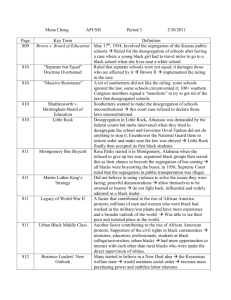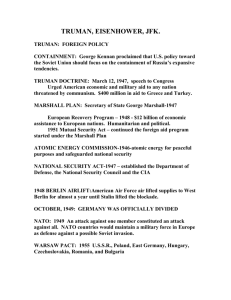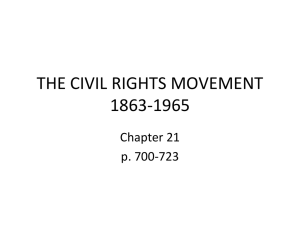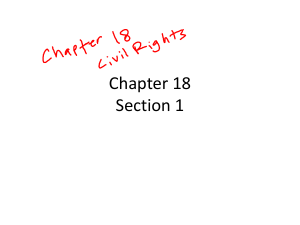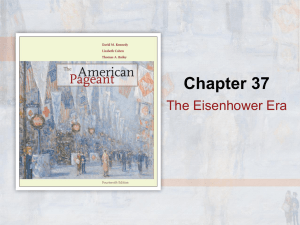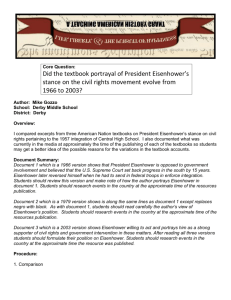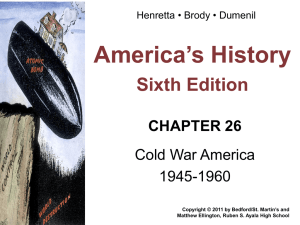File - Social Studies
advertisement
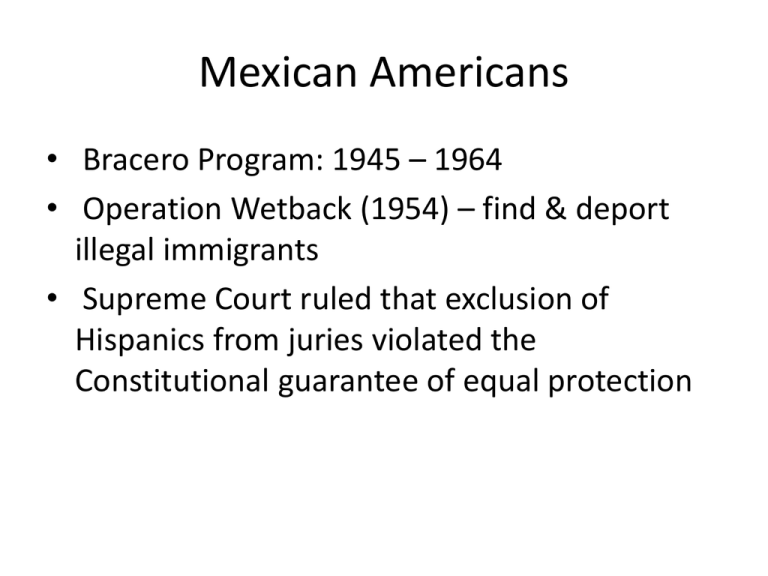
Mexican Americans • Bracero Program: 1945 – 1964 • Operation Wetback (1954) – find & deport illegal immigrants • Supreme Court ruled that exclusion of Hispanics from juries violated the Constitutional guarantee of equal protection Civil Rights • Zinn page 449 – 457 • Although the 1960’s are usually considered the decade of greatest achievement for Black civil rights, the 1940’s and 1950’s were periods of equally important gains. Assess the validity of this statement. “Or Does It Explode” The black revolt of the 1950s and 1960sNorth and South-came as a surprise. But perhaps it should not have. The memory of oppressed people is one thing that cannot be taken away, and for such people, with such memories, revolt is always an inch below the surface. For blacks in the United States, there was the memory of slavery, and after that of segregation, lynching, humiliation. And it was not just a memory but a living presence-part of the daily lives of blacks in generation after generation. -Zinn CH 17 “Or Does It Explode” In the 1930s, Langston Hughes wrote a poem, "Lenox Avenue Mural": What happens to a dream deferred? What is the dream deferred? Does it dry up like a raisin in the sun? What happens when a dream Or fester like a soreAnd then run? Does it stink like rotten meat? Or crust and sugar overlike a syrupy sweet? Maybe it just sags like a heavy load. Or does it explode? is deferred? Emergence of Civil Rights • • • • • Overcome political & social barriers ALL southern states enforced Jim Crow Laws Employment discrimination Voting laws – enforced discrimination 1950’s created a movement of change! – grassroots movement attracted national attention – Supreme Court ruled for reform – African Americans created organizations & utilized civil disobedience President TRUMAN: EO 9981 • October 29, 1947: The President's Committee on Civil Rights condemns segregation wherever it exists and criticizes specifically segregation in the armed forces. • July 26, 1948: President Truman signs Executive Order 9981, • establishes the President's Committee on Equality of Treatment and opportunity in the Armed Services. Autherine Lucy and the University of Alabama • In 1952, Autherine Lucy accepted to Univ of Alabama • As an African-American, state law prohibited her attendance • Marshall and other lawyers worked with Lucy to sue the university -U.S. Supreme Court ruled in 1955 Lucy could go to the University of Alabama. • February 1956, a mob of people assembled on campus to stop desegregation. Lucy is suspended. University of Alabama students burned desegregation literature. 1954: School Desegregation • 1954 Brown v. Board of Education • “Separate educational facilities are inherently unequal” thus violated the 14th amendment. • Unanimous Court headed by Chief Justice Earl Warren • Decision? – "The Race Question," a 1950 statement published by The United Nations Educational, Scientific and Cultural Organization (UNESCO), a specialized agency of the UN. rejected race theories & 20th Century Eugenics movement – An American Dilemma: The Negro Problem and Modern Democracy (1944). This study of race relations, funded by the Carnegie Foundation detailed obstacles to full participation that African-Americans faced in 1940s American society. DECISION • Educational psychologists: The "doll test" studies – found contrasts among children attending segregated schools in Washington, D.C. versus those in integrated schools in New York. – Black children often preferred to play with white dolls over black ones. – When asked to fill in a human figure with the color of their own skin, the children frequently chose a lighter shade than was accurate. – Children assigned "good" and "pretty" attributes to the white dolls, and "bad" and "ugly" attributes to the black dolls. – The Clarks testified as expert witnesses – The Supreme Court viewed their work as evidence that the children had internalized racism caused by being discriminated against and stigmatized by segregation. Eisenhower • connect the issue with national security by pointing out that the Communists around the world were using racial discrimination in the U.S. as anti-American propaganda • Blues guitarist J.B. Lenoir, recorded "Eisenhower Blues" in 1954 - he laments the lack of social gain or economic opportunity afforded blackshttp://www.youtube.com/watch?v=x-gHnx1p6JY • January 15, 1955 President Dwight D. Eisenhower signed Executive Order 10590, establishing the President's Committee on Government Policy to enforce a nondiscrimination policy in Federal employment. Eisenhower • Mike Wallace & Thurgood Marshall interview – did Eisenhower do enough? http://www.youtube.com/watch?v=IoPLitU6jV g Sarah Keys v. Carolina Coach Company, 1955 • Warren Court ruled that the non discrimination language of the 1887 Interstate Commerce Act prohibited segregation of black passengers in buses traveling across state lines. • The case had grown out the frustrations felt by a Women's Army Corps (WAC) private who experienced this form of discrimination while traveling in uniform in the service of her country. • It was the first time the court applied the Brown v. Board logic to the field of interstate transportation. • The ruling was issued on November 7, but was made public just one week before Rosa Parks refused to give up a bus seat in Montgomery, Alabama. The Murder of Emmett Till, 1955 • • • • • • 14-year-old Emmett Till, from Chicago, was murdered in Mississippi where he had gone on vacation to visit relatives. Till entered the store and allegedly spoke or whistled flirtatiously to 21-year-old Carolyn Bryant Till was never seen alive again. When his body was found in the Tallahatchie River three days later, it was apparent that the men had beat him and gouged out one of his eyes. Then they shot him in the head, tied a cotton gin fan to him with barbed wire so as to weigh him down, and tossed him in the river. After about an hour of deliberation the jury acquitted Roy Bryant and J.W. Milam, A year later, protected by double jeopardy, they admitted to killing him Black reaction: made them realize for the first time that they could be killed just for being black. White Reaction: those who were indifferent to the plight of African Americans were appalled by the brutality of this particular murder. Rosa Parks & the Montgomery Bus Boycott, 1955-1956 Rosa Parks • Parks was arrested and charged with violating the segregation law. • Four days later, Parks was tried for violating that law, and for disorderly conduct. • She was found guilty and fined $10, plus $4 in court costs. Parks appealed her conviction. • Parks became the catalyst for the boycott of the Montgomery buses. Montgomery Bus Boycott • Highlighted commitment • Persistence • Nov. 1956 – Supreme Court declared Alabama’s bus segregation unconstitutional 1956: presidential election year - segregation issue dominated Democratic Party politics • Eisenhower (R) v. Adlai Stevenson (D) • Eisenhower: largely ignored the civil rights issue, ended the Korean War and the nation was prosperous Southern Christian Leadership Conference (SCLC) • Dr. Martin Luther King, Jr. - chairman of organization (Atlanta) • main task - gain footholds in the black churches and communities across the South • coordinate local protests against segregation and disfranchisement • CORE & NAACP: coordinated mass movements Ruby Bridges inspired the 1964 Norman Rockwell painting "The Problem We All Live With": On November 14, 1960, the nation watched as six-year-old Ruby Nell Bridges walked into William Frantz Elementary School and into history. A federal court ordered the New Orleans school system to desegregate, making Bridges the first AfricanAmerican to attend the elementary school. The Little Rock Integration Crisis, 1957 • On September 4, Arkansas Governor Orval Faubus exercised his authority to deploy the state National Guard to support segregationist protestors who were physically blocking access to the school. • President Eisenhower sent the 101st Airborne Division of the United States Army President Eisenhower and Civil Rights Legislation • 1957 was a turning point for President Eisenhower on the race issue • leadership shown during the Little Rock crisis • proposed to Congress the first Civil Rights Act since Reconstruction – The bill passed the House 270-97, and the Senate 6015. Eisenhower signed it on September 9, 1957. – The goal of the Civil Rights Acts of 1957 had been to ensure voting rights for African Americans. Civil Rights Act of 1957 • established the Civil Rights Section of the Justice Department and empowered federal prosecutors to obtain court injunctions against interference with the right to vote. • established a federal Civil Rights Commission with authority to investigate discriminatory conditions and recommend corrective measures. Sit-Ins • 1958: a non-violent occupation of a place • The first organized lunch-counter sit-in for the purpose of integrating segregated establishments began in Wichita, Kansas. • The Greensboro Four On February 1, 1960, four freshman students from a College in North Carolina - sat down at a "white's only" lunch counter inside a Woolworth's store in Greensboro, North Carolina, and ordered coffee.
